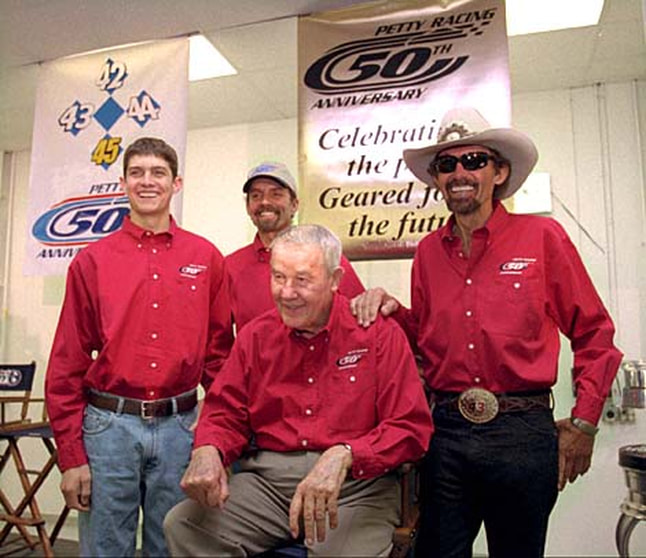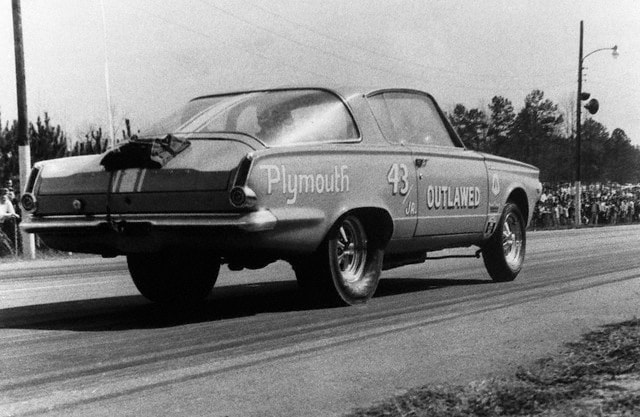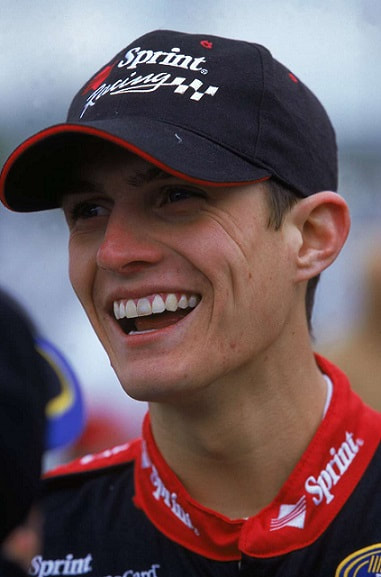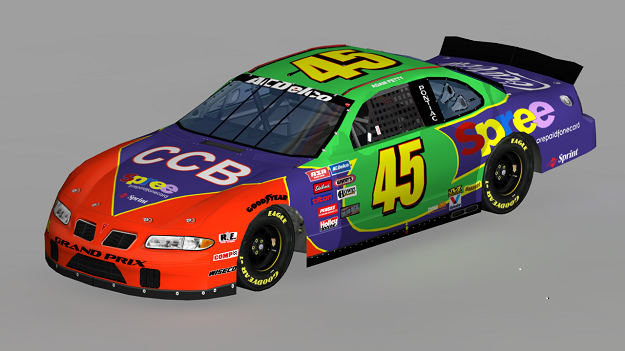Author’s Note: I bid you welcome, gentle readers. It took your scribe 15 years to get this piece to the point where I felt it was acceptable for print. That was 6 years ago. All dates and events will remain in the original time frame, so make allowances for things that have changed… the illness of Pattie Petty and the eventual divorce between her and Kyle; the passing of Judy Allison, who is mentioned herein. I know these things happened, but I want this effort to stand as written.
Why now and not on the anniversary of his death? Because on Sunday night at Darlington, Adam’s car was the throwback choice of Petty Enterprises and they presented an amazing likeness of his car, with only a slight number change, from 45 to 43. Victory Junction Camp stood as sponsor, making it a true family effort.
Once again, I was reminded that just because I knew who Adam was and how he died, doesn’t mean that younger fans have any reason to know. Sadly, he’s been gone as long as he was alive and another whole generation has grown up without ever seeing or in many cases even hearing much about him. It’s for those folks that I offer this today, as we remember Adam Petty one more time.
Today we’ll be looking back at a very young driver that had the whole world in his hands and a promising career in racing all mapped out for him. That young man was Adam Petty, the first fourth-generation driver to compete professionally in the upper echelons of stock car racing. It’s hard for me to conceive that it’s been 15 long years since Adam was taken from us in a practice crash at the track in Loudon New Hampshire on May 12, 2000. That means that among my younger readers, he is remembered only distantly, if at all. Adam was the son of Kyle Petty, grandson of “King” Richard Petty and great-grandson of NASCAR Hall of Fame driver Lee Petty, one of the “originals” in NASCAR. Adam was, indeed, the hope of continuing the Petty dynasty.

I’m sorry to say that I never met young Adam or watched him race from anywhere other than the comfort of my living room, but as a member of the “First family” of stock car racing, his name, face and patented “Petty smile” were familiar to all race fans. His death was a tragic blow that cast a pall of sadness over the entire racing world. Being a member of the Petty clan guaranteed him recognition; being so young, with so much promise, unfortunately guaranteed him nothing. Death, I’ve heard it said, has no conscience, and Adam Petty will remain forever 19.
This memorial to Adam will contain few, if any, statistics. If you are not familiar with the racing history of the Petty family, please consult http://racing-reference.info, click on “drivers” and overdose on the numbers that the older generations amassed over the years. Sadly, young Adam never had the chance to put up great statistics or set records. Our purpose here today is to remember Adam Petty, not numbers.
Much like so many sons of racers, Adam began going ‘round in circles at an early age, six, to be exact, in go-karts. After that, he ran in a few “Mini Sprints” races, ran the Legends Car series, attended the Bob Bondurant School of Driving and of course, the “Richard Petty Driving Experience.”
He “introduced” himself to NASCAR in 1997, running 25 races in the NASCAR Weekly Racing Series, now known as the K & N Series. On April 11, 1998, at the tender age of 17, Adam made his debut in the professional ranks of racing when he ran his first race in the American Speed Association (ASA) at Peach State Speedway in Jefferson, Georgia, just down the four-lane a piece from where I lived at that time. Later that same year, on September 30, Adam won the Easy Care 100 ARCA race at Charlotte Motor Speedway in Concord, NC. He is pictured here along with proud Grandpa Richard and proud Dad, Kyle.

Perhaps no one was prouder on that day than “Grandpa” Richard, who commented, “I was overwhelmed with pride when Kyle got into racing, but to see yet another generation begin is just incredible. Now Kyle can feel what it’s like to see the family tradition go on.”
Kyle, however, knew that he had never materialized into the successor his father had hoped for. His thoughts at that time were, “My son can be what my father was.” At another time, while visiting his parents’ house, Kyle later shared this bit of conversation; “Daddy and Adam were walking together in the backyard, talking. As I looked out the window at them, I told my mother, ‘Richard Petty’s finally got the son he never had.'”
Richard made no bones about Adam being a favorite in his heart either. “Adam has more desire than Kyle ever had,” said Richard. “When Kyle came along, he wanted to drive a race car, but he also wanted to ride his motorcycles, play his guitars, get married the first thing — all sorts of stuff. Adam is really, really focused.”
The closeness between grandfather and grandson would become even closer when a tragedy took place during an ASA race in Minnesota on September 9, 1998. Adam’s crew chief, Chris Bradley was crushed beneath his car when the Jackman lowered the car with Chris under it. He passed away during surgery for his injuries.
“Chris didn’t tell Adam or anyone else in the crew that he was going under the car to make an adjustment”, Richard said. “The routine is, when the new tires are on, the Jackman lets the car down. It’s Adam’s job to take off when the car comes off the jack. That’s what he did. He didn’t have any idea anybody was under the car. He thought he’d run over a tire or an air wrench, until they stopped the race.”
That’s a very heavy load for an 18-year old to carry, but Grandpa was first on the scene with comfort and understanding. Adam spoke of the tragedy after the Charlotte ARCA win. “I’ve been torn up for the past several weeks. When I got home [to Randleman, N.C.] from Minnesota, I was devastated. The first person to meet me was my grandfather, telling me he’d gone through the same thing many years before.”
Without going into heavy details on Richard’s career, in 1965, when he was part of a Chrysler boycott of NASCAR in a dispute over engine specifications, Richard competed briefly in drag racing, driving a car he called “Outlawed.” At a dragstrip in Dallas, Ga., his dragster went out of control and into the crowd, killing an eight-year-old boy. No one can relate to grief quite as well as someone that has shared it.

Adam made his first Winston Cup start on April 2, 2000 at Texas Motor Speedway, driving the Petty Enterprises #45 Sprint sponsored Chevrolet. (Adam drove Chevrolets in the Busch Series that year. Listed owner was Kyle Petty, not Petty Enterprises, which at the time fielded Pontiacs. My guess would be it was contractual that he drove a Chevy in what would become his only Cup start.) He started 33rd and finished 40th with a blown engine, making 215 laps around the 1.5-mile speedway his entire Winston Cup career. On April 5, 2000, just three days after watching Adam make his first Winston Cup start, Petty family patriarch Lee Petty passed away after a long illness. Lee was 86.
Adam was then in his second season with the Busch Series and plans were to drive five Cup races in 2000 in preparation for driving full-time in Cup in 2001 and running for Rookie of the Year. That would have had him driving one of the new Petty Enterprise Dodges as teammate to his dad Kyle, and John Andretti.
Of course, as is the case with any death in our racing family, a million and one quotes can be found, as everyone expressed his or her shock and grief at the loss of one so very young, but from all of that I’ve chosen one that I feel represents what everyone was feeling and expressing at that time. It comes from 1995 Busch Series Champion Johnny Benson Jr.
“This is tragic. When I heard this, I could not believe it. To have someone so young and with such a bright future ahead of him die like this is a hard thing to swallow. It’s so rare for this to happen in NASCAR because they have made the cars so safe in recent years. Sometimes you get lulled into thinking it can never happen.”
Looking back with ever-20/20 hindsight, one might call that “prophetic”, or perhaps more appropriately, “tempting fate.” There had not been an on-track death in NASCAR’s upper tiers since John Nemechek was killed in a Craftsman Truck Series race in Homestead, Fla., in 1997. The last death occurring in the Busch Series had been Clifford Allison, the younger son of NASCAR Hall of Famer, Bobby Allison. Clifford Allison was killed during practice for a race at Michigan International Speedway in 1992.
“Sometimes you get lulled into thinking it can never happen.” Gentle readers, if that doesn’t sound familiar to everyone reading, it should… especially in this time of begging and pleading with NASCAR to get the SAFER barriers installed everywhere feasible at every track. What followed Adam’s death and Johnny’s statement seemed almost like a roll of thunder echoing throughout the racing world… as if God were angry with racing for not protecting its own. If we thought that racing deaths were rare, we were about to learn that could change in the blink of an eye, and of course, we were also about to learn much more about something called “basal skull fracture”, the listed cause of Adam Petty’s death.
On July 7, 2000, Kenny Irwin Jr. was killed in a Winston Cup practice at the same Loudon track that had claimed Adam just 2 months earlier. Listed cause of death was basal skull fracture.
On October 13, 2000, Tony Roper was killed at Texas Motor Speedway in a Craftsman Truck Series crash, head on into a wall. No autopsy was performed, so cause of death is listed loosely as “neck injuries.” Suspected actual cause of death was basal skull fracture.
On February 18, 2001… the day the light went out of racing… seven-time Champion Dale Earnhardt was killed on the last lap of the Daytona 500 at Daytona International Speedway. Listed cause of death was basal skull fracture.
On October 4, 2001, Blaise Alexander was killed in an ARCA race at Charlotte Motor Speedway. Listed cause of death was… basal skull fracture.
Since then of course, NASCAR and other stock car and open-wheel sanctioning bodies have cleaned up their act to a large extent. Speaking for NASCAR, as that is the venue with which I am most familiar, all drivers wear a mandated full-faced helmet and a mandated HANS device or its equivalent. This is a proven head and neck restraint that does not allow the head to be cast forward at full racing speed when the vehicle comes to a sudden stop. I’m not sure they are mandated, but every driver in the upper tiers uses a fitted seat that conforms to his/her personal form and measurements. These are mostly constructed from carbon fiber today, rather than the hard and unforgiving metals of days past.
We still fight an ongoing battle to have SAFER barriers installed in more places at more tracks. It’s been 15 years since the death of Adam Petty set the wheels of safety reform in motion, albeit slow motion. It cannot be denied that it was the death of Dale Earnhardt that turned the racing world on its ear and taught us that, “Hey, this can happen to anyone.” Quite frankly, NASCAR did not listen when the warning bells tolled for Adam, Kenny and Tony. One fair question that I have asked throughout all those years is, “Why was not the HANS device mandated after Adam’s life came to a tragic end?”
There was nothing Adam Petty wanted more than to become a NASCAR Winston Cup driver. He had the desire; he had the talent, and as Richard said, he had that all-important focus… and he was a Petty. Adam and the entire Petty clan saw that dream come true on April 2, 2000. Forty days later, Adam Petty was no more.

The grief that Adam’s death brought to the Petty family is far beyond my descriptive powers, gentle readers. I have long believed that no parent should outlive his/her child… ever. I’ll leave you to imagine what you might feel in the same circumstances. What Kyle did, after taking a little time to adjust to the situation and console his family as best he could, was schedule a press conference from Petty Enterprises. This man, who has done so much for others and lost so much himself, announced to the world while choking back tears, that if Adam couldn’t drive the #45 “Sprint” sponsored car as he had been scheduled to, then his Dad would do it for him. Kyle took the wheel of his son’s #45, which he drove exclusively from then on, in Adam’s memory.
Even before Adam’s premature death, Kyle and Pattie had become interested in a series of camps known as the “Hole in the Wall Gang”, which were run by Paul Newman of acting and racing fame. These camps help children with terminal or debilitating diseases to cope with their problems and simply get more out of what life God has given them. They are very extensive in scope, with full medical facilities and anything the mind can conceive these children might need to make life better. The Pettys had visited a camp in Florida in 1998 and left with the desire to create one of their own. They began working toward this goal, along with Paul Newman, and the plans for “The Victory Junction Gang Camp” were already on the drawing board but were put aside temporarily when Adam was taken from them.
Time does somehow manage to heal, if only a bit, and their interest in the camp came back, accompanied by the donation of a large parcel of land in Randleman N. C. by Richard and Lynda Petty. The camp opened in the summer of 2004 and was dedicated to the memory of Adam Petty. Meanwhile, Kyle and Pattie continued raising funds to support the endeavor and received a vast amount of help from the extended family of racing in making the dream come true.
Today, Victory Junction Camp stands as a beautiful remembrance of a young man who gave far more than he ever had a chance to know. From the death of Adam Petty eventually came the first meaningful and serious improvements in racing safety in decades. Also from his death and in his name came Victory Junction Camp, an organization designed solely to make life easier for hundreds and thousands of children challenged by debilitating illness or crippling pain… none of whom are named Adam Petty, but each of whom has had his or her life enriched in a very special way because once upon a time, there was a young man by that name.
In closing, please let me share one final gift that Adam’s death gave to the racing world. NASCAR Hall of Fame driver Bobby Allison, head of the famous “Alabama Gang” and his long-time wife Judy had finally divorced under the strain of Bobby’s career-ending crash at Pocono in 1988, followed by the loss of youngest son Clifford in 1992, killed in a practice crash at Michigan International Speedway and the loss of oldest son Davey in a helicopter crash at Talladega Superspeedway in July of 1993. Still, feeling it was their place to be at the side of Kyle and Pattie Petty as they grieved the loss of their son Adam, Bobby and Judy drove to North Carolina together to pay their respects.
Upon seeing the pair, once so vital in the racing world, now stooped a bit with age and sorrow, Pattie Petty whispered softly the words, “Y’all have been there” and more of her ever-present tears flowed as she was embraced by these two friends that had too many reasons to understand her grief and feel her sorrow. Sometime after being reunited for Adam’s funeral, Bobby and Judy remarried and remain together today… a sweet and lasting memorial to the life of a young man gone too soon, and one more of the thousands of reasons to remember Adam Petty.


Be well gentle readers, and remember to keep smiling. It looks so good on you!
~PattyKay

(Editor’s note: This story is publish with the permission from the author! It was originally published on RaceFansForever; Adam Petty (racefansforever.org) )



